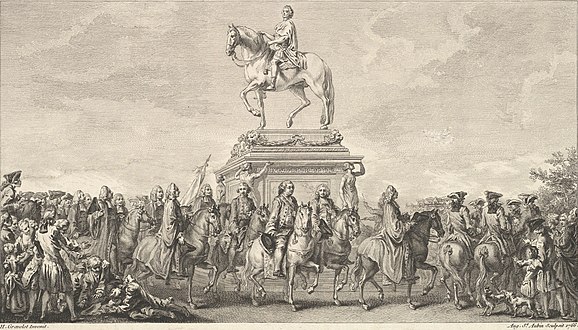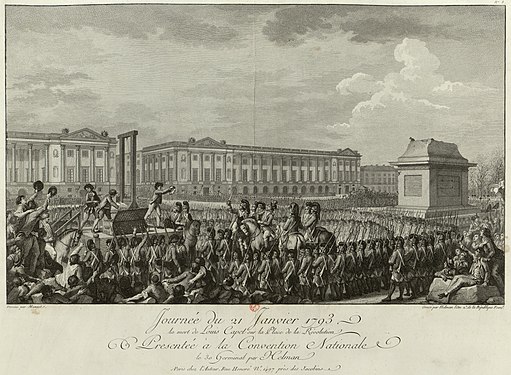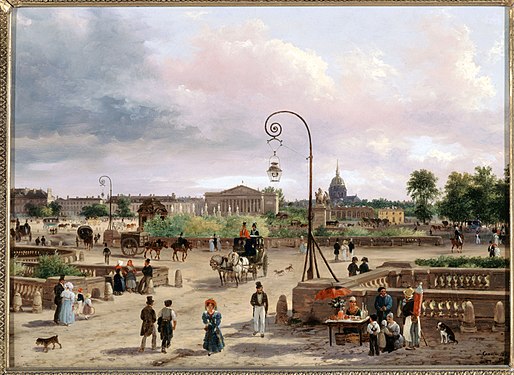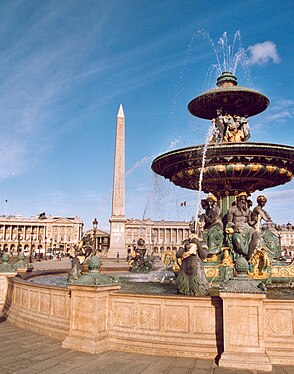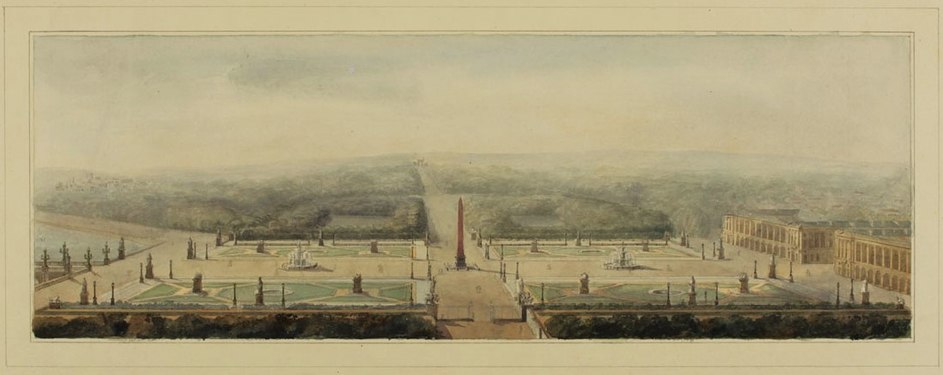Place de la Concorde
Coordinates: 48 ° 52 ' N , 2 ° 19' E
| Place de la Concorde | |
|---|---|
| location | |
| Arrondissement | 8th. |
| quarter | Champs-Élysées |
| morphology | |
| length | 360 m |
| width | 210 m |
| history | |
| Emergence | 1763 |
| designation | 1830 |
| Original names | Place Louis XV (1763) Place de la Révolution (1792) Place de la Concorde (1795) Place Louis XV (1814) Place Louis XVI (1826) Place Louis XV (1828) |
| Coding | |
| Paris | 2262 |
The Place de la Concorde ( plas də la kɔ̃kɔʁd ; German Platz der Eintracht ) is the largest square in Paris with 8.64 hectares . It is located north of the Seine ( Rive droite ) in the 8th arrondissement between Jardin des Tuileries and Avenue des Champs-Élysées .
The Place de la Concorde is 359 meters long and 212 meters wide and an area of 68,470 sqm on the Place des Quinconces in Bordeaux is the second largest place of France, is next to the Place des Vosges , Place Dauphine , Place Vendôme and Place des Victoires to the five royal squares of the city ( French Place Royale ).
Location and access
The Rue Royale , the Avenue Gabriel, the Rue de Rivoli , the Cours la Reine with the Port de la Conference, Voie Georges Pompidou, Port de la Concorde, Quai and Port des Tuileries as well as the Seine Bridge all flow into the Place de la Concorde Pont de la Concorde . The obelisk with its gold-plated tip is in the line of sight from the Louvre to the Arc de Triomphe at the Étoile on the Ax historique . The other line of sight at this point runs at right angles from the church and Place de la Madeleine to the south over the Seine to the building of the National Assembly , the Palais Bourbon .
Located close to the center, the square has a central position, because two major traffic arteries cross here:
- The north-south axis from Montmartre past the Grands Magasins des Boulevard Haussmann , the Église de la Madeleine to the Assemblée nationale .
- The west-east axis from the Grande Arche via the Avenue de la Grande Armée , the Place Charles-de-Gaulle with the Tunnel de l'Étoile and the Avenue des Champs-Élysées to the Jardin des Tuileries and the Musée du Louvre .
The Place de la Concorde can be reached by
-
Metro on the station Concorde , ,




-
Bus of the RATP 24, 42, 52, 72, 73, 84, 94, OpenTour and Noctilien
 11, 24
11, 24
Name origin
The name was chosen by the board of directors to document the reconciliation of the French with the excesses of the reign of terror .
Place description
From an urban planning point of view, the entirety of the square is an important creation of the Enlightenment period ( French Siècle des Lumières ). It excellently expresses the evolution of French taste: the formation of a new style, classical architecture in the 18th century, pioneered by the architect Ange-Jacques Gabriel and the sculptor Edme Bouchardon with his in the middle of the square and during the revolution destroyed equestrian statue of Louis XV. belonged.
The name of the square has been changed several times, reflecting the instability of the political regimes of France since 1789 and a series of happy, tragic or glorious events, some of great historical importance, that have taken place on its soil. It was called “Place Louis XV”, then “Place de la Révolution” after August 10, 1792, “Place de la Concorde” under the Directory , the French Consulate and the First Empire , then again “Place Louis XV” afterwards “Place Louis” XVI »under the Restoration , in 1830« Place de la Charte », to finally reassume the name« Place de la Concorde » under the July Monarchy; the same fate suffered the statues that adorned or should have adorned the square: the equestrian statue of Louis XV. , Statue of Liberty , statue of Louis XVI. , Obelisk of Luxor .
While the design of the square was still modest under the revolutionary government (the Chevaux de Marly were brought onto the square from the Jardin des Tuileries in 1794 ), there were huge changes under the July monarchy : First, the obelisk was erected in 1836. This was followed by the beautification work by Hittorff : the two fountains, the statues of eight important French cities, the street lighting ( French Lampadaires ) and the Colonnes rostrales . During the Second Empire , the square was completely redesigned to improve the flow of traffic. The last redesign took place in 1931 with the demolition of the Hôtel Grimod de La Reynière and the establishment of the United States Embassy in Paris in its place. In 1937 the square was listed ( French classée ) and therefore no longer changed.
history
Originally, the square was in the middle of swampy terrain and was often flooded by the Seine .
18th century
Initially, there were several possible locations for the new square on both sides of the Seine. King Louis XV Eventually decided on vacant land at the end of the Tuileries Gardens that belonged to him, which at the time was outside the city limits and was called Place du Pont Tournant . On a map by Covens & Mortier from 1742, there was arable land at this point, which immediately adjoined the Tuileries Gardens. The construction plans of the architect Ange-Jacques Gabriel from September 7, 1755 ensured that the original 84,000 m² area was rounded off in 1755. His plan was approved in December 1755. The patent for the development of the square with the name Place Royal , given in 1753, was granted by the administration on June 21, 1757 with a validity until October 30, 1758. Gabriel was to surround the square , which was to be laid out as an octagon, with a ditch. The purpose of the square was to display an equestrian statue of Louis XV made by Edmé Bouchardon . to give a worthy location. Bouchardon began work on the equestrian statue as early as 1749 ; his inauguration on the square, which was still under construction, took place on May 10, 1765. On May 30th, 1770 there was a fireworks display in the area, which was still limited by trenches, causing panic that resulted in around 1200 deaths. After its completion in 1776, the square was initially named Place Louis XV . Since November 20, 1791, the Pont de la Concorde has connected the square with the Rive Gauche south of the Seine.
Revolution time
During the French Revolution , the equestrian statue was destroyed and removed on August 11, 1792 in the square now called Place de la Révolution . In their place a guillotine was erected on January 21, 1793 , with which Louis XVI. was beheaded. It was followed by his wife Queen Marie Antoinette (October 16, 1793), Louis-Philippe II. Joseph de Bourbon, duc d'Orléans (November 6, 1793) and the revolutionaries Georges Danton (April 5, 1794) and Maximilien de Robespierre ( April 28 , 1793) July 1794; see also the list of people executed during the French Revolution ); 1,345 people were executed here within only 2 ½ years.
Sanson shows the head of Marie-Antoinette to the crowd, 1793. ( Musée de la Révolution française )
19th century
Scarred by the bloody terror and execution of the royal family, the square was a political problem for 19th century governments. After the Statue of Liberty under the consulate was removed and plans to erect a statue of Charlemagne , then a fountain, were abandoned, it was finally Louis XVIII. , who has a monument in the middle of the square in memory of his brother Louis XVI. wanted to build: the statue of the martyred king, framed by a chapel and a weeping willow . Charles X laid the foundation stone on May 3, 1826. In the same year the square was renamed “Place Louis XVI” (the plaque is still today on the corner of Rue Boissy-d'Anglas ). But the intended statue was never erected because the work was interrupted by the July Revolution of 1830 and the square was given its final name, “Place de la Concorde”.
During the July Revolution of 1830 there was fighting between the insurgents and the regular troops in the square.
In 1831 the Viceroy of Egypt offered [[Egypt # Rise and Independence under the Muhammad Ali Dynasty | Muhammad Ali Pascha ]], France the two obelisks at the entrance of the Luxor temple from Thebes . Only the first of these came to France and reached Paris on December 21, 1833. Louis-Philippe I decided, on the basis of “il ne rappellera aucun événement politique”, that it should be placed on the Place de la Concorde. The delicate operation of construction was carried out under the direction of the engineer Apollinaire Lebas and in front of more than 200,000 spectators on October 25, 1836. Unsure whether the operation would succeed, the King and his family watched the work in the salon of the Hôtel du Garde-meuble and only then appeared on the balcony to receive the applause of the crowd when the monolith was erected.
The square was given its current appearance between 1836 and 1840 based on drawings made by the architect Jakob Ignaz Hittorff, who grew up in Cologne and who lives in Paris, from 1829, while retaining the basic layout by Gabriel. He added two monumental fountains (which were made of cast iron as a special feature) on either side of the obelisk and surrounded the square with lampposts and beak-shaped columns. The square is intended to highlight the performance of French ship technology, because the Ministry of Navy was housed in one of the two town houses built by Gabriel. The two fountains - inaugurated on May 1, 1840 by the Préfet Rambuteau - are the river (north fountain: two seated figures represent the Rhine and the Rhone; grape harvest and grain harvest are symbolized) and sea shipping (south fountain: Mediterranean, ocean and fishing ) dedicated. The architect secured the support of numerous artists for the design of the figures on the fountains: Jean François Théodore Gechter , Honoré Jean Aristide Husson , François Lanno , Nicolas Brion , Auguste-Hyacinthe Debay , Antoine Desboeufs , Jean-Jacques Feuchère , Antonin-Marie Moine , Jean-Jacques Elshoecht (called Carle Elshoecht) and Louis-Parfait Merlieux . The beak-shaped columns carry ship arches, which also correspond to the symbol of the city of Paris. The eight allegorical statues of French cities border the octagon imagined by Gabriel.
In 1854 the trenches that Hittorff had planned were filled in to better adapt the space to traffic.
German troops camped on the site in March 1871 during the Franco-Prussian War . The Paris 1900 World Exhibition took place between April and November 1900, the entrance halls of which were located on the square.
Place de la Concorde, before its transformation in the reign of Louis-Philippe I , painting by Giuseppe Canella (1829)
Fountain by Jacques Hittorff on the Place de la Concorde
Place de la Concorde - from a perspective view, 1829, Jakob Ignaz Hittorff , Wallraf-Richartz-Museum, Cologne
Place de la Concorde - Ministry of the Navy ( Charles Meryon , 1865)
Place de la Concorde - entrance gate to the Paris World Exhibition 1900
20th century
- On February 6, 1934, a demonstration of the extreme right took place on the square. Clashes with the police resulted in 20 deaths and 2,300 wounded.
- The Place de la Concorde with its paving, fountains, statues, sentry boxes, balustrades, columns and lampposts is classified as a historical monument by decree of March 23, 1937 .
- On May 30, 1968, the Gaullists held a counter-demonstration.
- On July 14, 1979, Jean Michel Jarre gives a concert.
- On December 1, 1993, for AIDS World Day, the Act Up-Paris gathers on the square, covers the obelisk with a 30 m long condom and baptizes the square in “ Place des morts du Sida ” ( German: Platz der AIDS-Toden ) .
- On May 7, 1995, the supporters of Jacques Chirac gather and celebrate his election as president. This is to commemorate a similar event on May 10, 1981, when François Mitterrand celebrated his election on the Place de la Bastille .
- In 2000, the free climber Alain Robert climbed the Obelisk without prior notice and without being secured.
21st century
- On May 6, 2007, Nicolas Sarkozy , like Jacques Chirac in May 1995, celebrated his victory in the presidential election. On April 15, 2012, he also held a counter-demonstration to François Hollande , who gathered his supporters on the Esplanade du château de Vincennes square.
- In the summer of 2007 the square was closed to traffic in order to be able to shoot the film by Éric et Ramzy Seuls Two .
Buildings
Hôtel de Crillon and Ministry of the Navy
Architect Gabriel made sure that the square should only receive buildings on its north side. Construction of the neoclassical buildings built by Gabriel with their monumental Corinthian columns and colonnades began between 1757 (western part) and 1765 (eastern part); they were completed by 1775. Gabriel only created the facades and left it to the buyers to have the buildings on the plots behind them designed according to their own individual needs. Both buildings dominate the Place de la Concorde on its north side, the 250-meter-long north facade of which is separated by the Rue Royale. The entire building complex has a usable area of 15,240 m². In 1775, the Hotel de Coislin (No. 4; 2880 m²) moved into the western part of the building, sorted by house number, and in the same year David-Etienne Rouillé de l'Estang acquired No. 6. Marquise Marie de Plessis-Bellière moved into it before 1852 and called it the Hôtel de Plessis-Bellière (No. 6; 1440 m²), next to it were the Hôtel Cartier (or Hôtel Moreau , after Pierre Moreau ; No. 8) and the Hôtel d'Aumont (No. 10; 2920 m²). All of them were not hotels in the modern sense, but city villas ( French Hôtels particuliers ). On the other side of the Rue Royale in the eastern part in No. 2 was the royal furniture and equipment room since 1771 ( French Garde-Meuble de la Couronne ; 8000 m²). On October 6, 1789, the Ministry of the Navy moved here .
In the former Hôtel Coislin , Benjamin Franklin signed a friendship and trade treaty between France and the United States on February 6, 1778 . Louis-Marie-Augustin d'Aumont, Peer of France , lived in the Hôtel d'Aumont between 1777 and 1782 . On April 20, 1788, François Félix de Crillon bought this building for 300,000 livres and gave it his name. The Crillon family lived here for generations. As a hotel in today's sense, it has only been functioning as the Hôtel de Crillon since March 11, 1909 , a grand hotel with 120 rooms (46 of which were suites, 2 of which were designed by Karl Lagerfeld ). After the two neighboring Hôtels particuliers Plessis-Bellière (the Marquise died here on June 7, 1876) and Hôtel Cartier remained unused, they were merged in 1895; Since November 12, 1895, the Automobile Club de France (No. 6–8), to which the buildings have belonged since 1898, has resided here .
For more than 100 years, the use of these buildings has remained largely unchanged. President Nicolas Sarkozy set up a commission in February 2011 to explore the future use of the Ministry of the Navy. Because in January 2015 the entire staff of the Navy moved to the new headquarters of the Ministry of Defense in Hexagone Balard near the Balard metro station . The restoration of the Navy Ministry will take place between 2017 and 2019, during which a decision will be made on a new use. The renovated Hôtel de Crillon opened on July 5, 2017.
obelisk
The highly visible Obelisk of Luxor is one of the temples of Luxor originating 23.50 meters high and about 230-ton granite - Monolith (from syenite ) from the 13th century BC , situated on 25 October 1836 a Jakob Ignaz Hittorff built a 5 meter high base. It is a present from Muhammad Ali Pascha to King Louis-Philippe in recognition of the achievements of Jean-François Champollion , who did not arrive in Paris until August 1834 after a difficult sea voyage. The approximately 1,600 hieroglyphs proclaim the glorious deeds of Ramses II . The oldest monument in Paris received a 3.60 meter high pyramidion made of gilded bronze on May 14, 1998 . The obelisk is supposed to symbolize the difficult way to achieve unity ( French concorde ) in a people. Every year the celebrations for the French national holiday come to their climax on July 14th.
Fountain and candelabra
The obelisk is flanked by two fountains built by Hittorff, each with a diameter of 16.50 meters. Two smaller ones rise above the larger round water basin. The southern ( French fontaine des mers ) is dedicated to the Mediterranean and Atlantic seas as well as seafaring and fishing, the northern ( French fontaine des fleuves ) is adorned with allegories of the Rhône and Rhine rivers as well as agriculture and industry. Four genii each concretize these allegories. The fountains were inaugurated on May 1, 1840 by Prefect Claude-Philibert Barthelot de Rambuteau , and they were renovated in 2002.
Hittorff also had the 20 cast candelabra made based on his drawings as an allusion to the Navy Ministry ( French colonnes rostrales ). Hittorff's trademarks are these cast iron candelabra and the rostral columns. Gabriel created eight statues of women between 1753 and 1763, symbolizing the eight largest cities in France. The seated city goddesses stand on the bases of former sentry boxes. These allegories represent the French cities of Bordeaux , Lille , Brest , Rouen , Lyon , Marseille , Nantes and Strasbourg .
Place de la Concorde - Hôtel de Crillon (October 2008)
Quote
Curzio Malaparte : "La place de la Concorde n'est pas une place, c'est une idée."
Some people who have been guillotined here
- Louis XVI , January 21, 1793.
- Marie-Antoinette d'Autriche , October 16, 1793
- Charlotte Corday , July 17, 1793
- The Girondins , October 30th and 31st, 1793.
- Olympe de Gouges , November 3, 1793
- Louis-Philippe II. Joseph de Bourbon, duc d'Orléans , November 6, 1793
- Madame Roland , November 8, 1793
- Jacques-René Hébert , March 24, 1794
- Georges Danton , April 5, 1794
- Camille Desmoulins , April 5, 1794
- Jean-Joseph de Laborde , April 18, 1794
- Antoine Laurent de Lavoisier , May 8, 1794
- Jean-Baptiste Tavernier-Boullongne , May 8, 1794
- Élisabeth de France (1764-1794) (Mme Élisabeth), May 10, 1794
- Maximilien de Robespierre , July 28, 1794
- Louis Antoine de Saint-Just , July 28, 1794
- Georges Couthon , July 28, 1794
- François Hanriot , July 28, 1794
In the beginning, the bodies were transferred to the Cimetière de la Madeleine (now Square Louis XVI ), where they are still today.
From 1794 the remains of the condemned were brought to the Cimetière des Errancis . On the occasion of the urban development measures in the 19th century, the remains were excavated and disorganized in the catacombs .
In the cinema
- Place de la Concorde (film, 1896) by Georges Méliès (1896, lost)
- Place de la Concorde (film, 1939) by Karel Lamač
- An American in Paris by Vincente Minnelli (1939)
- Fantomas (1964) by André Hunebelle (1964)
- Le Magnifique - I'm the Greatest by Philippe de Broca (1973)
- An elephant is very wrong by Yves Robert (1976)
- La Soif de l'or by Gérard Oury (1993)
- Jet Set by Fabien Onteniente (2000)
- Les Rois mages by Bernard Campan and Didier Bourdon (2001)
- In the Star Trek universe, this square is the headquarters of the Presidency of the United Federation of Planets .
The painter's point of view
- Place de la Concorde , oil on canvas by Albert Lebourg , Paris , Musée Marmottan
- Place de la Concorde (Degas) , 1875, oil on canvas by Edgar Degas , Saint Petersburg , Hermitage
- Place de la Concorde , 1909, oil on canvas by Henri Le Sidaner , Musée des beaux-arts de Tourcoing
literature
- Todd Porterfield: The Obelisk on the Place de la Concorde. Post-Revolutionary Politics and Egyptian Culture . In: Wilfried Seipel (Ed.): Ägyptomanie. European imagination of Egypt from antiquity to today . Kunsthistorisches Museum, Vienna 2000, ISBN 3-85497-016-1 ( Writings of the Kunsthistorisches Museum 3), pp. 62–82.
- Labīb Ḥabašī: The immortal obelisks of Egypt. Revised and expanded new edition by Carola Vogel. Zabern, Mainz 2000, ISBN 3-8053-2658-0 , 89ff.
- Thomas Ketelsen, Volker Zander (ed.): Paris awakens! Hittorff's invention of the Place de la Concorde , Wallfraf-Richartz-Museum, Cologne 2017 (catalog on the occasion of the exhibition of the same name, Cologne, April 7 to July 9, 2017), ISBN 978-3-923154-44-9
Web links
- Les guillotinés : Genealogy of the guillotined
- La place en images : Collection of images on the history of the Place de la Concorde
Individual evidence
- ↑ TOP5 des plus GRANDES places de Paris
- ↑ During the Second Empire, the traffic management in Paris was redesigned by Georges-Eugène Haussmann .
- ^ Karl Baedeker, Paris and Vicinity , 1876, p. 133
- ↑ Gustave Isambert, La vie à Paris pendant une année de la Révolution (1791-1792) , 1896, p. 22
- ↑ Heidemarie Plessing, Gable Sculptures in Paris from 1660-1860 , 2008, p. 110
- ↑ G. Byrne Bracken, Walking Tour Paris , 2012, p. 72
- ↑ German He will (here) not be remembering any political event.
- ↑ Entry No. PA00088880 in the Base Mérimée of the French Ministry of Culture (French).
- ↑ www.persee.fr: Manifestation gaulliste du 30 may 1968 place de la Concorde
- ↑ Harold Koda / Andrew Bolton / Metropolitan Museum of Art (New York; eds.), Dangerous Liaisons: Fashion and Furniture in the Eighteenth Century , 2006, o. P.
- ^ Century Company, The Century Illustrated Monthly Magazine , Volume 71, 1906, p. 260
- ↑ Ulrike Schuster, Urban Utopias and Ideal City Concepts of the 18th and 19th Centuries Using the Example of the City of Paris , 2003, p. 32
- ↑ German The Place de la Condorde is not a place, but an idea.



